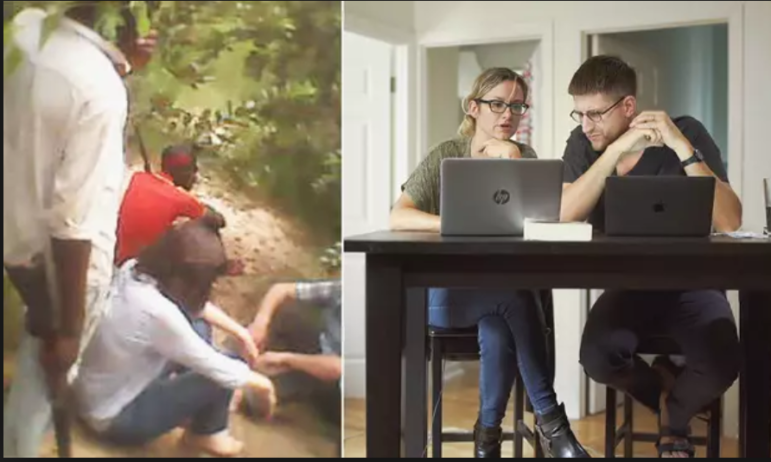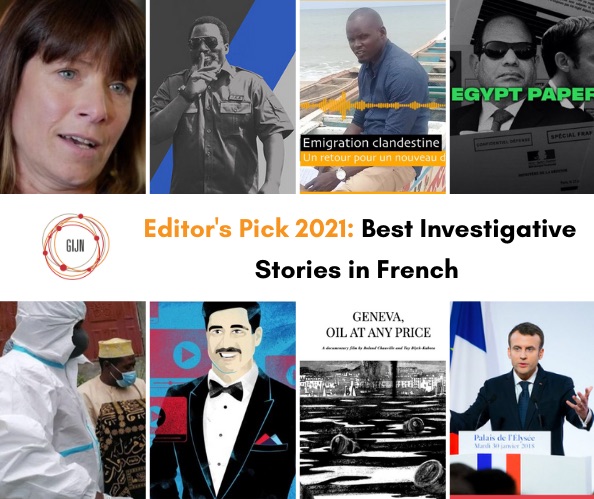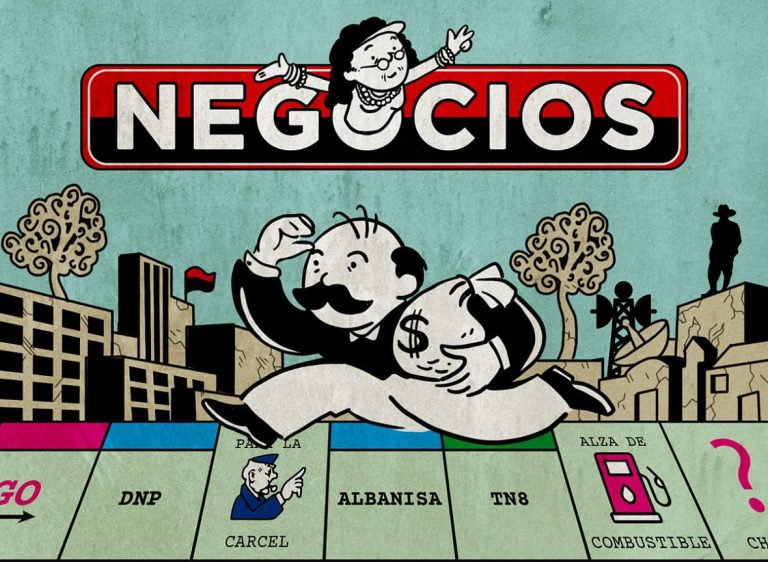

Axel Gordh Humlesjo of Mission Investigate and Sonia Rolley, a reporter with Radio France Internationale, analyze the image seen to the left — the moment before the murders of two UN experts in March 2017.
How They Did It: Reporting a UN Murder Cover-Up in the DRC
On November 27, 2018 at 7:30 p.m. Central European Time, five separate media organizations broke similar stories on a United Nations cover-up of the murders of their own staff. It took nothing less than the “radical sharing” of information between these rival platforms to expose a global conspiracy of silence.
The stories revealed that two UN human rights experts – Michael Sharp and Zaida Catalán – were lured to their deaths in the Democratic Republic of the Congo (DRC) by government intelligence agents posing as interpreters. The articles stunned the diplomatic world by revealing that the UN investigation deliberately hid the DRC government’s involvement in the murders in its own report.
Sweden’s TV newsmagazine, SVT Mission Investigate, and four other media partners were recently recognized with an Investigative Reporters and Editors medal for taking “a huge institution, the UN, to task for looking the other way when murders were covered up.”
DRC government officials had blamed the rebel group Kamuina Nsapo for the 2017 murders, releasing a gruesome execution video to support their claim. And the UN’s lead investigator echoed this claim in the official UN report, even criticizing Sharp and Catalán for using motorcycle taxis, rather than security escorts.
But a team of reporters from SVT, Le Monde, Radio France Internationale, Foreign Policy Magazine and Süddeutsche Zeitung used several leaks of UN documents, audio from sources, a damning analysis of the video and in-country interviews to reveal both sinister military involvement and a UN whitewash of the causes. The reports have led to calls for independent investigations of incidents involving UN staff, and the jailing of a DRC army colonel whose links to the conspirators were exposed by phone records unearthed by the SVT team.
Deceptive Diplomacy
Mission Investigate has won 10 international awards for Sweden’s public service TV company, and its “Deceptive Diplomacy” captured more than one million viewers for its Swedish broadcast alone.
Axel Gordh Humlesjö, a lead reporter and producer for Mission Investigate, said the radical sharing approach used for the investigation not only made the story work, but also triggered a series of downstream benefits, such as unimpeachable credibility, cover for at-risk reporters and digital cross-promotion.
The radical sharing strategy, made famous by the International Consortium of Investigative Journalists (ICIJ) in its Panama Papers collaboration, involves active cooperation and total data transparency between otherwise rival media platforms. Typically, the approach features an agreed publication date and is used for stories with large data sets or cross-border challenges.
There was no proportionality limit on the UN cover-up story: All reporting teams got access to everything – except the most sensitive source work – and all publications could publish what they wanted from the material, independently.
“With this investigation, we had a big data set in this leak, and we really needed help,” says Humlesjö. “We needed the help of local Congolese journalists; of Foreign Policy Magazine to pull strings at the UN in New York; we needed help on the language and the behind-the-scenes and many other aspects. It was really a great example of international media cooperation. We had meetings in Paris – and I do think it’s important for trust to shake someone’s hand – and then we had group chats on Signal’s encrypted channel, and monthly encrypted conference calls hosted by Süddeutsche Zeitung.”
Silenced
Catalán and Sharp were shot to death near the village of Bunkonde on March 12, 2017, and buried in shallow graves.
The narrative from the government and the UN was that the two human rights experts had been killed by the rebel group for unknown reasons, and that their recklessness in failing to use security escorts or heed warnings had contributed to the tragedy.
But the Mission Investigate story offered evidence for both a conspiracy and a motive: Catalán and Sharp had been searching for evidence of a Congolese military atrocity in the area – specifically, mass graves – and that they were set up to be silenced. In fact, analysis by Radio France Internationale showed that the actual orders to shoot the experts were issued in Lingala — the one language that Kamuina Nsapo rebels refuse to speak, as a matter of honor.
Another audio recording shows that the day before the murders, the pair were warned by a senior rebel figure that “they will be attacked” if they traveled to Bunkonde. But the documentary shows – astonishingly – that the two interpreters present deliberately mistranslated the warning to advise the pair of the opposite, saying “you can go there; no problem.” The team revealed UN investigation documents that identified the interpreters as undercover agents for the Congolese security services, a stunning fact that was excluded from the UN report.

Maria and Elizabeth Morseby (left) — the mother and sister of murdered UN expert Zaida Catalán (seen right) — react to evidence that the conspiracy surrounding Catalán’s death was covered up. Photos: Courtesy SVT
The SVT team also identified the central figure in the conspiracy – Congolese army Colonel Jean De Dieu Mambweni – and used phone records to show that he had communicated both with the fake interpreters and his supposed rebel enemies in the days leading up to the murders. The joint team also compared cell tower data with leaked documents to expose his false testimony in court when two rebel members faced trial for the killings.
Nils Hanson, who is now investigative editor for SVT News, says the radical sharing approach also aided the fact-checking process.
“It was important that all the partners in the project got access to the full leak so everybody could draw their own conclusions from the material,” says Hanson. “In that way, it becomes much more bulletproof, since all journalists could correct each other and find flaws in our reporting. This was a new way of working: trusting all of the team members from different countries to influence the reporting for the whole project.”
Critical to the story was that two sisters had the same instinct for secretly recording key conversations. Just as Catalán had recorded the “warning” meeting of March 11, her sister, Elizabeth Morseby – back in Sweden – later recorded the UN’s investigator admitting an alternate agenda to his report in a visit to the family. He is heard saying: “In the report, I don’t say ‘army’ or things like that because we want the Congolese to continue to work with us on this. We don’t want to make the report so bad that they cease cooperating. There’s a line they don’t want to cross in terms of implicating them.”
Humlesjö says: “My first reaction to the evidence of the fake interpreters was shock, and the second, of course, was to confirm: Can this be true? But it was very hard for me to believe that the UN would sacrifice the truth about its own [murdered] experts just to preserve relations with the brutal Kabila regime. I mean – why? But I first understood the scope of this mentality when we heard the recording… explaining this bizarre justification to the family, of all people. Pure deception.”
The Power of Partnerships
Humlesjö admits that the use of classified documents and secret audio recordings do present a potential problem for international media collaborations, with different laws operating in various countries and states.
In the end, he says the partners were careful to use secret audio depending on which US state the person was in at the time of the recording, and that Foreign Policy Magazine, in particular, was careful to use confidential documents deemed legal in their jurisdiction.
The collaboration also posed potential disclosure and embargo challenges, as its partners ranged from radio and magazine to online news and TV documentary; TV, for instance, needed five extra weeks for editing.
Humlesjö says the key lay in joint decisions on timing. He says they decided to “make the story official” – revealing their full evidence to responding sources – only after all at-risk western reporters had left the Congo, and within four weeks of publication, after video editing work had already started for SVT. While SVT’s Congolese media partner was unable to publish directly due to the threat of reprisal, the collaboration enabled it to at least get the facts out by “reporting on the reporting.” Indeed, Humlesjö told GIJN that two courageous Congolese journalists vital to the investigation could finally be named: Caleb Kabanda and Sosthene Kambidi of Actualité.
In addition, he says: “There was great cross-promotion. Foreign Policy Magazine put up our video on its webpage, and we put up their link on our social media. It turned out that each of our stories were a great complement to the other. This is not to forget that this whole project would not have been possible without the cooperation of our local partners in the Congo, who really were the heroes of this story because they were working on the ground, and suffering the potential consequences of reporting on these facts in a dangerous area.”
Humlesjö says audience trust emerged as one of the greatest benefits of the radical sharing model.
“Earlier, you’d have to trust one established title, like The New York Times, and trust that there were no agendas and that everything was correct,” he says. “But now, readers can know that four of five separate titles have gone through the same information and come up with similar conclusions. I think this was important for media in the Congo, who were threatened and discredited by politicians. The fact they could say to their audience that Western media agreed with them – that this fact is true, that these people are responsible – is very important for journalists who don’t operate in a free press environment.”
 Rowan Philp is a multiple award-winning journalist who has worked in more than two dozen countries. Currently based in Boston, Philp was the chief reporter and London bureau chief for South Africa’s Sunday Times for 15 years.
Rowan Philp is a multiple award-winning journalist who has worked in more than two dozen countries. Currently based in Boston, Philp was the chief reporter and London bureau chief for South Africa’s Sunday Times for 15 years.









